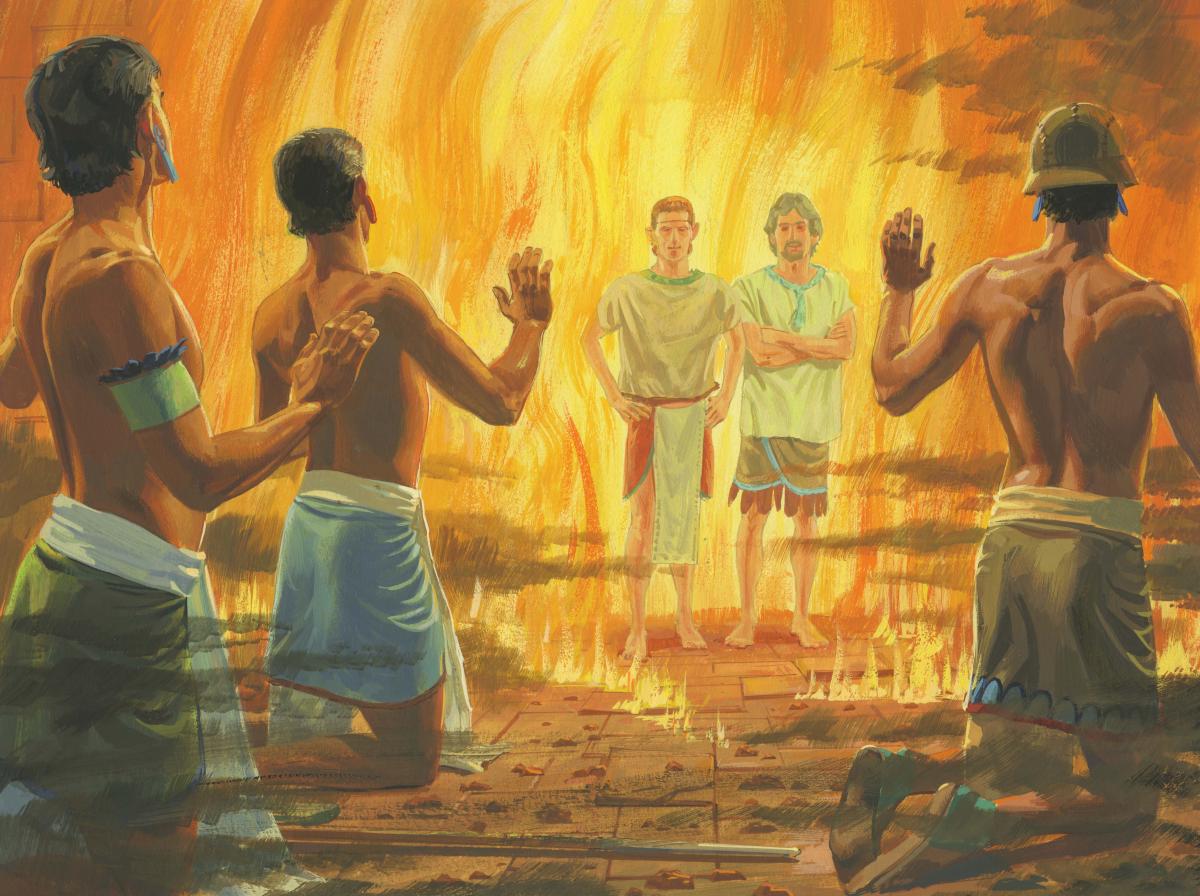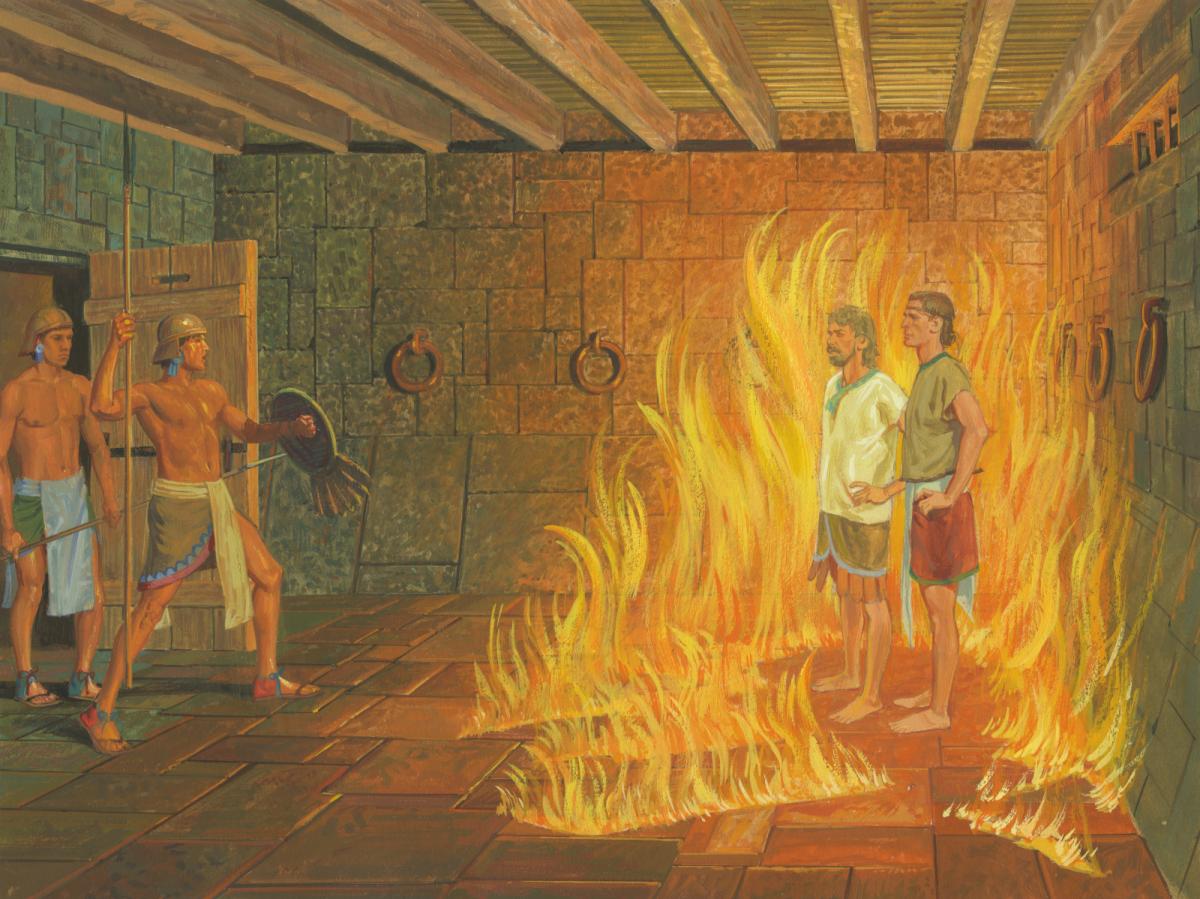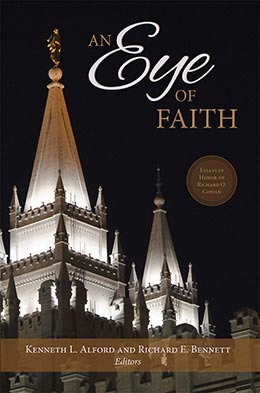Missionaries in War and Peace (Helaman 4–5)
S. Kent Brown
S. Kent Brown, “Missionaries in War and Peace (Helaman 4-5,” in An Eye of Faith: Essays in Honor of Richard O. Cowan, ed. Kenneth L. Alford and Richard E. Bennett (Provo, UT: Religious Studies Center; Salt Lake City, 2015), 305–19.
S. Kent Brown was a professor emeritus of ancient scripture, Brigham Young University when this article was published.
 As outlined in the book of Helaman, Nephi and Lehi experienced several dramatic experiences while serving as missionaries to the Lamanites. " (Painting by Jerry Thompson.)
As outlined in the book of Helaman, Nephi and Lehi experienced several dramatic experiences while serving as missionaries to the Lamanites. " (Painting by Jerry Thompson.)
Richard Cowan represents the best of what I experienced among colleagues during my years at BYU. Not only did he and I find our offices close to one another during a stretch of time but, as I judge from our collegiality, we also enjoyed a mutual respect for each other. Certainly on my side, I regularly knocked on his door and, when invited into his office, I asked one or more questions that he graciously and accurately answered, most often with humor. His generosity on those occasions, and many others, has left me in his debt. But that debt is not something that he expects me to pay back to him. Like other colleagues in Religious Education, I was to pay the debt by answering the questions of others, whoever they might be, in as gracious and thorough a manner as I could. To me, he was the exemplar of how a teacher is to interact with students, colleagues, and the curious.
The year 35 BC did not end well for the Nephites. The following year, 34 BC, was even worse. A large Lamanite army, egged on by the shrill voices of Nephite dissenters, swept down from the highlands in the South and in one bloody battle after another, savagely drove the Nephite people and their armies out of their beloved Zarahemla and then out of city after city. When the weary Nephite armies finally held their ground in the land Bountiful, stretching their defenses from the west sea to the east, the Lamanites had captured “all the lands” between Zarahemla and Bountiful (Helaman 4:5–7). For the Nephites, it was a total disaster. What follows is a story about failure on a military and political front and, unexpectedly, stunning success in a focused preaching effort. In short, the word from a divine source is more powerful than the sword (see Alma 31:5).[1] Further, the Lord assists those who stand with him, even and especially when they find themselves in extreme difficulty. Moreover, a desperate cry to the Lord from normally rough and ready men inside a prison gives birth to a new people of God.
We can only imagine the desperate scenes in the Nephites’ flight for safety—parents looking desperately for missing children even as they try to save their own lives; family members grabbing treasured items from their homes and then being slowed in their flight from danger because of the burdens; expectant mothers running and all the while wondering whether they and their unborn babies will survive; the elderly and disabled trying unsuccessfully to find someplace to hide; and those who do not learn of the invasion until it is too late being swept down in death by their enemies.[2]
The accommodations inside cities where people retreat are desperate. Hastily arranged, the people packed inside suffer from lack of food, water, shelter, and medicines. Even though the hosts surely make heroic efforts to make the refugees comfortable, children cry almost constantly because they are hungry and thirsty. Many women give birth away from familiar surroundings, instead aided by the skilled hands of strangers. Of the infants born in these days, we expect that many die because they are premature. People young and old try their best to bind up wounds without the necessary supply of salves and ointments. Because quantities of needed goods are stretched thin, people scrounge through the surrounding countryside for food and for anything to keep them out of the heat and rains. Sanitation is overburdened. We can imagine that, at times, the smells of death and illness and human waste are everywhere. Such conditions of squalor in the refugee cities will persist for the three years of conflict.[3]
In the middle of this calamitous military defeat stands the head of the Nephite state, a man named Nephi, son of Helaman. He, of course, bears the ultimate responsibility for the unprepared state of his army. His people have looked to him for protection and, in their minds, he has failed them. To his credit, however, under his leadership and that of his commanding officer, a man named Moronihah, over a three-year period the Nephite armies take back “half of all their possessions.” But this success comes at a high human cost. Mormon, the author of the account, writes of “great slaughter” among the Nephites (see Helaman 4:10–11).
Because Mormon has another agenda in his history writing, he does not write about the conditions inside cities overburdened with refugees and the growing public dissatisfaction with Nephi, the chief judge. Instead, he looks for the deep, underlying causes of the disaster, causes that go back to “dissensions in the church” and “contention among the people” coupled with “pride” and “making a mock of that which was sacred” (Helaman 4:1, 12). But the public backlash must have been intense. After all, the survivors have lost everything—family members, homes, lands, livestock—and they naturally look for someone to blame. Nephi is the most prominent leader in their sight. Even though Mormon knows the real reasons for the calamity, and lists them, public pressure forces Nephi to resign, even though a large portion of the population has begun to repent and to heal (see Helaman 4:12–13, 20–26; 5:1–2). From all appearances, Nephi’s political influence, and that of his family, has been dashed.
But this is not the end of the story. Nephi shows himself to be a person of enormous resilience and brimming confidence in divine aid. Besides, despite public opinion about him, he clearly understands the real reasons for the disaster—his people’s “wickedness” (Helaman 4:11).[4] Instead of withdrawing from public life in shame, he figuratively changes his clothes, taking off the clothing of a national political and military leader and donning the garments of a missionary. Then, with his younger brother Lehi, Nephi begins to devote himself to preaching,[5] the two of them motivated by the teachings of their father Helaman (see Helaman 5:4–14). At that point, everything begins to change. One important observation is that the word will do what the sword cannot do, as the account soon demonstrates.
As we might expect, the two brothers begin their preaching tour among their own people, many of whom have returned to their home towns because of the successful actions of the Nephite army (see Helaman 5:14–15). Nephi and Lehi spend substantial time in the Nephite-held zone, perhaps many months. Their preaching efforts include those who are living in temporary housing, but especially those who are refugees and are former residents of Zarahemla, the capital city, and its surrounding region. The Lamanites still hold this city. At the end of their preaching tour among their fellow countrymen, the two brothers head for Zarahemla, undaunted. But they must cross a hostile military frontier. And that means moving through a frontier controlled on either side by nervous soldiers.
In our imaginations we can easily see these two men approaching the Nephite side of the dividing line. We reasonably assume that they are carrying identification of some sort. The Nephite soldiers must have been astonished to learn that the brothers, from one of the most prominent families in the country and one of whom is the former head of state, want to walk into Lamanite-held territory. After some questioning, Nephi and Lehi are allowed to pass. But, perhaps a few dozen yards away, the Lamanite guards surely will make the rest of the experience more difficult. We can almost hear the questions from the guards and next from the officer in charge. We then sense a long delay, and finally hear more questions. Nephi and Lehi persist. They will not be turned back. Whatever reasons they give, the border guards are eventually satisfied. The two are allowed to pass. Mormon collapses this entire scene into “they had gone . . . into the land of Zarahemla, among the Lamanites” (Helaman 5:16). Innocent stuff? Hardly. The two missionaries carry a divine motivation, a history of achievement, and God’s word.
The brothers soon enjoy missionary success in the capital city, but not among the Lamanites, initially. Apparently, Nephi and Lehi originally seek out the “dissenters”—the former Nephite citizens—for their message, preaching among them “with great power.” The experience is not easy. These former Nephites argue with and cajole the missionaries. It is only with monumental effort that the brothers are able to “confound many of those dissenters,” leading some of them to “confess their sins and [be] baptized unto repentance.” Of course, not all accept the preaching message. But a large number do. And they are so deeply touched that they “immediately returned to the Nephites to endeavor to repair unto them the wrongs which they had done” in whipping up the Lamanites to go to war in the first place (Helaman 5:17). Step one now is as complete as it can be made, with the powerful aid of God’s word. Now for step two.
Zarahemla and its environs are filled with Lamanite families who have moved down from their highland homes and are now living in former Nephites’ homes. Mormon does not reveal why they have come, assuming he even knows why. Perhaps it is a resettling program initiated by the Lamanite royal household. Perhaps not. Whatever the case, these newcomers to the Nephites’ former capital city become the audience for Nephi and Lehi’s preaching. We notice at this point that it is remarkable the two brothers are not deported back to Nephite-held territory in accord with a long-standing Lamanite policy which provided for deportations, among other options (see Alma 17:20). Instead, they evidently enjoy free reign to pursue their missionary efforts. And those efforts pay handsome dividends.
First, the Lamanites in the city experience “great astonishment” at the “great power and authority” of the brothers’ preaching. Obviously, they have never seen or heard someone speak in such a way about matters of faith. Second, their initial surprise turns to a genuine change of heart and results in the baptism of “eight thousand of the Lamanites,” an unexpectedly high number of converts. One suspects, however, that the multitude of converts was not completely unexpected by the two brothers. Third, with an ironic twist, what may be more surprising is that, while these Lamanites are living in homes and tending gardens that once belonged to Nephites, they become “convinced of the wickedness of the traditions of their fathers,” a point of view that the Nephites have been championing all along (see Helaman 5:18–19; Alma 37:9; 60:32). Although no one can see it yet, the brothers have laid foundation stones for peace.
The third step is taken when the two missionaries depart Zarahemla and their converts, presumably leaving them in the capable hands of newly called church leaders. But they don’t go back across the hostile border into the comfort and security of Nephite-held lands. Instead, they turn south and upward, ascending to the city of Nephi, the capital of the Lamanite kingdom. They cover the distance in twenty days or so.[6] This is where things become interesting, but only after the brothers are arrested and put into prison. What their captors do not know is that they carry the power of the word.
On the broad canvas of international affairs, it is worthwhile noting that, when Nephites show up in Lamanite territory, which is the customary destination for Nephite dissenters, Lamanite officials are empowered to exercise one of several options, as noted above. They can either “slay [the Nephites], or . . . retain them in captivity, or . . . cast them into prison, or . . . cast them out of [the] land” (Alma 17:20). In the case of Nephi and Lehi, authorities put them in prison while they discuss over “many days” what to do with these Nephite intruders. Sadly, nothing is preserved of the conversation between the brothers and their captors, and we do not know whether Lamanite officials learn that Nephi is the former head of the Nephite state. If they somehow learn this fact about him, their discussions about his fate surely become all the more deliberate. It is one thing to kill the head of state who is part of an army in the midst of battle. It is quite another to execute another state’s former chief official when two states are ostensibly at peace. Finally, however, someone makes the decision. The brothers Nephi and Lehi are to die.
 Nephi and Lehi were cast into prison by the Lamanite army. (See Helaman 5:20-22.) (Painting by Jerry Thompson.)
Nephi and Lehi were cast into prison by the Lamanite army. (See Helaman 5:20-22.) (Painting by Jerry Thompson.)
We are not informed whether, during the days that officials are deliberating the fate of the brothers, they somehow learn about the activities of the two missionaries in Zarahemla. If they become aware, that fact alone will spur them to act decisively to cut off any Nephite influence among their people of whatever sort, especially religious influence. After all, within memory stand the activities of the sons of the Nephite King Mosiah. From the Lamanites’ perspective, those men converted thousands of fellow Lamanite citizens, led them off to Nephite lands, and then turned them against their mother civilization by settling them in a place called the land of Jershon and protecting them with the Nephite army (Alma 27:22–24). Whatever their motivation, the authorities send a squad of soldiers—we notice the plural pronoun, “they went forth into the prison”—to “slay” the brothers (Helaman 5:22; emphasis added). Because the prisoners have spent “many days without food,” perhaps the squadron expects to find them already dead or at least near death. But when the detachment of soldiers arrives, it finds the brothers very much alive and, to the surprise of the soldiers, enjoying their isolation (Helaman 5:22–24).
We presume that, even though the prison is part of a walled, open space that will accommodate several hundred people (see Helaman 5:27, 31, 49), the interior of the prison is dark. That would make the next scene all the more stunning. For when the squadron opens the door, its members see that “Nephi and Lehi were encircled about as if by fire” (Helaman 5:23). Out of the door pours light, light that evidently cannot be seen until the door is opened. Fear grips the soldiers and “they durst not lay their hands upon [the missionaries] for fear lest they should be burned.” Amazingly, the brothers are “standing in the midst of fire and [are] not burned.” In a sentence that must rest on the brother’s recollection of the experience and not on the soldiers’ memories as much of the account does, we learn that “when [the brothers] saw that they were encircled about with a pillar of fire, and that it burned them not, their hearts did take courage” (Helaman 5:24). From this, it seems clear that the fire bursts into flame about the time that the soldiers open the prison door. It has not been burning for a long time inside the room because the brothers are as surprised as the soldiers. At this moment, it seems, the brothers begin to see that the Lord stands with them, even in their extreme difficulties.
 The ground and prison shook as a voice spoke three times. Though terrified, the Lamanites could not run away due to the darkness that surrounded them. (See Helaman 5:33-34.) (Painting by Jerry Thompson.)
The ground and prison shook as a voice spoke three times. Though terrified, the Lamanites could not run away due to the darkness that surrounded them. (See Helaman 5:33-34.) (Painting by Jerry Thompson.)
What the brothers seem not to expect is the soldiers’ utter surprise and fear. The soldiers become completely immobilized, standing “as if they were struck dumb with amazement.” Sensing what is happening, the two missionaries take the initiative, talking to their captors in reassuring tones: “Fear not,” one of them says, “for behold, it is God that has shown unto you this marvelous thing, in the which is shown unto you that ye cannot lay your hands on us to slay us” (Helaman 5:25–26). But this quiet reassurance, which consists of divinely crafted words, is suddenly broken by a strong earthquake.[7] In quick succession, the approximately “three hundred souls” gathered at the prison, perhaps expecting to witness the execution of the Nephite prisoners, undergo an unprecedented experience. Nothing prepares them for what happens next.
Those present, whose numbers include “Lamanites” as well as “Nephites who were dissenters,” perhaps having experienced earthquakes in the past, must sense that something strange is taking place. For, although “the earth shook exceedingly” in the first tremor, the prison walls “did not fall.” To add to their amazement, “a cloud of darkness,” perhaps mixed with dust stirred by the earthquake, descends upon the area and overshadows them all, evidently cutting off the daylight. Now, “an awful solemn fear came upon them” (Helaman 5:27–28). They are genuinely afraid.
Then out of the midst of the darkness, “as if it were above the cloud,” comes a mild voice, almost “a whisper” that pierces them “to the very soul,” saying words, words that are totally unexpected: “Repent ye, repent ye.” We might excuse these people for thinking, why do we need to repent? The voice answers immediately any such questions: they need to repent because they “seek to destroy my servants whom I have sent unto you to declare good tidings.” Who is speaking? Who is behind the voice and these words? Those in the crowd don’t have time to mull such questions because, almost without delay, “the earth shook exceedingly, and the walls of the prison trembled again.” In our mind’s eye, we can see all three hundred hunkering down on the ground. No one is still standing. Except perhaps the two brothers, of course. For them, the Lord’s miraculous powers are unfolding. And they hear his reassuring, familiar words. For the others, the experience is sheer terror.
The voice and its words return, this time with an added message: “Repent ye, repent ye, for the kingdom of heaven is at hand; and seek no more to destroy my servants” (Helaman 5:32; emphasis added). For the third time, “the earth shook . . . and the walls trembled,” followed by the voice declaring “marvelous words which cannot be uttered by man.” The experience for the prison crowd rises to an awe-inspiring level. As if to add emphasis, “the earth shook” more severely than before, “as if [the earth] were about to divide asunder.” No one moves. They cannot see to flee and they are transfixed with fear (Helaman 5:32–34).
 As the darkness lifted, the Lamanites saw a pillar of fire surrounding Nephi and Lehi. (See Helaman 5:43-44.) (Painting by Jerry Thompson.)
As the darkness lifted, the Lamanites saw a pillar of fire surrounding Nephi and Lehi. (See Helaman 5:43-44.) (Painting by Jerry Thompson.)
While the two missionaries wait patiently, witnessing the unrolling of the Lord’s stunning powers, and the others remain in their places, too frightened to move, one man figures things out. His name is Aminadab, and he is a former church member who once lived in Nephite territory. In the gloom, he looks around and, “through the cloud of darkness,” he sees “the faces of Nephi and Lehi.” Astonishingly, their faces “did shine exceedingly.” More than this, their gaze is upward, into the darkness, “as if talking or lifting their voices to some being whom they beheld.” Aminadab shouts to everyone to look. Until this moment, all are as if paralyzed where they have crouched or fallen. But, apparently unable to move, they receive an enabling “power [that is] given unto them” and now turn toward the prisoners and “behold the [shining] faces of Nephi and Lehi” (Helaman 5:35–37, 39). Notably, these are words that come from the crowd inside the prison. They become witnesses to the enabling power of God.
What further astonishing experience might they undergo? Surely seeing the faces of the prisoners all lit up must top all others. No one has seen anything like it. And it has become clear to all that the two Nephites are connected to what has been happening. Someone in the crowd takes courage and, for the rest of them, asks Aminidab, “what do all these things mean, and who is it with whom these men do converse?” Answers to these questions will naturally tell them a lot. Remembering past religious lessons, Aminidab says matter-of-factly, “They do converse with the angels of God” (Helaman 5:38–39).
Impressed with this man’s grasp of the situation, another asks how to get rid of the cloud of darkness. Aminadab’s answer? “You must repent, and cry unto the voice, even until ye shall have faith in Christ.” Whose name is that? people are thinking. Aminadab anticipates their query. “Christ,” he shouts, “was taught unto you by Alma, and Amulek, and Zeezrom” (Helaman 5:40–41). Here, we ask, who among the three hundred has heard the preaching of these three prominent Nephites? Not all, of course. Perhaps only a few, but enough to make a difference. Most who know of these three preachers are Nephite dissenters who probably have heard these preachers either in the frontier city of Ammonihah (see Alma 14:6–7) or among the Zoramities (see Alma 31:1–8). Perhaps a couple of the Lamanite captors have spent time in Ammonihah and have heard the three preachers, or know about them. After all, Ammonihah is a city almost on the border between Nephite and Lamanite lands where Lamanites apparently can mix with people of other ethnic groups without fear.
 While standing untouched in the midst of the flames, Nephi and Lehi taught the Lamanites of God's power that was protecting them. (See Helaman 5:24-26.) (Painting by Jerry Thompson.)
While standing untouched in the midst of the flames, Nephi and Lehi taught the Lamanites of God's power that was protecting them. (See Helaman 5:24-26.) (Painting by Jerry Thompson.)
At Aminadab’s suggestion, those in the crowd begin to pray in earnest—the account says “to cry,” an intense form of prayer. It is important to observe in this context that, long before, Israel’s “beginnings as a people were grounded in a cry for help” (see Exodus 2:23–24; 3:7, 9; Deuteronomy 26:7).[8] Inside the prison, with this cry of hardened soldiers and prison keepers, we also witness a beginning of a new people of God. At the moment, these men do not foresee what is about to take place. But a beginning has begun to unfold.
 The Lamanites pleaded with him whose voice had shaken the earth. They prayed until the cloud of darkness was dispersed. (See Helaman 5:42.) (Painting by Jerry Thompson.)
The Lamanites pleaded with him whose voice had shaken the earth. They prayed until the cloud of darkness was dispersed. (See Helaman 5:42.) (Painting by Jerry Thompson.)
Immediately, the dark cloud disperses. But this is not all. Each of the captors is then “encircled about . . . by a pillar of fire,” just like the two missionaries. Here appears a second pointer to a fresh beginning, just as Jesus’ apostles and their hearers will experience on the Day of Pentecost (Acts 2:1–47) and as the children will experience on the first day of the Savior’s visit to the New World (3 Nephi 17:11–24).
Now, as the two brothers move among them, the captors witness that the “flaming fire” does not “harm” them nor does it burn “the walls of the prison.” In fact, the celestial fire fills them all “with that joy which is unspeakable.” Moreover, “the Holy Spirit of God did come down from heaven, and did enter into their hearts . . . and they could speak forth marvelous words.” The voice and its words return. This time the crowd hears, “Peace, peace be unto you, because of your faith in my Well Beloved.” Hearing these words, “they cast their eyes” upward and see “the heavens open; and angels came down out of heaven and ministered unto them” (Helaman 5:42–48), just as the children will experience in the Savior’s presence (3 Nephi 17:24). The eventful moment ends. But none of those present will ever be the same. And, of course, they will not stop talking about what has happened at the prison. Perhaps more important, Lamanite authorities cannot put a cap of silence on this occurrence. Word rushes headlong throughout the entire kingdom.
The stones in the foundation for peace between Lamanites and Nephites that Nephi and Lehi have laid in Zarahemla are now matched by the Lord in the remarkable events of one day in the city of Nephi, the stronghold of the Lamanite royal family. From the two centers spreads a revival-like movement that extends its warm, enlightening fingers into the entire Lamanite nation. Those present at the prison declare “throughout all the regions round about all the things which they had heard and seen.” The result? The “more part of the Lamanites were convinced.” The further result? The Lamanite people “lay down their weapons of war, and also their hatred [toward the Nephite people] and the tradition of their fathers.” In the end, the Lamanite armies “yield up unto the Nephites the lands of their possession” (Helaman 5:50–52). Against all odds, peace is achieved.
One of the remarkable results is an era of trusting interchange between peoples that has never been matched in their mutual history nor will it be matched again until the decades after the coming of the Risen Savior (see Helaman 6:3–8; 4 Nephi 1:1–17). Notable too, is the observation that what Nephi could not accomplish as an embattled head of state, he is able to accomplish in the company of his brother Lehi as a missionary. The experience of the two brothers bears out the truth of Alma’s earlier statement to the effect that “the preaching of the word [of God] . . . had a more powerful effect upon the minds of the people than the sword, or anything else” (Alma 31:5). Moreover, with a cry to the Lord from within a prison, a new people of God is born—the Lamanites in their homeland—just as ancient Israel was born with a cry to the Lord.
Notes
[1] Leslie A. Taylor, “The Word of God,” Journal of Book of Mormon Studies 12, no. 1 (2003): 52–63.
[2] Though we do not possess details of civilians’ flight before an invading army from Helaman 4, we see them elsewhere; see Alma 51:28; Helaman 1:24; Mormon 2:15, 18, 20; 5:5, 7.
[3] It is necessary to borrow from later descriptions of refugees fleeing from one city to the next in search of safety; see Mormon 4:19–21; 5:5–7.
[4] Richard O. Cowan, “The Lamanites—A More Accurate Image,” in The Book of Mormon: Helaman Through 3 Nephi 8, According to Thy Word, ed. Monte S. Nyman and Charles D. Tate Jr. (Provo, UT: Religious Studies Center, 1992), 257.
[5] R. Wayne Shute and Wayne E. Brickey, “Prophets and Perplexity: The Book of Helaman as a Case Study,” in The Book of Mormon: Helaman Through 3 Nephi 8, According to Thy Word, ed. Monte S. Nyman and Charles D. Tate (Provo, UT: Religious Studies Center, 1992), 183.
[6] John L. Sorenson, Mormon’s Codex: An Ancient American Book (Salt Lake City: Neal A. Maxwell Institute for Religious Scholarship and Deseret Book, 2013), 18, 121.
[7] The series of strong earth tremors (see Helaman 5:27, 31, 32, 33) very possibly tells us that the events take place in a seismic zone.
[8] Although we do not know the verb “to cry” in the Nephite and Lamanite tongues, we are justified in seeing it as related to the Hebrew terms that convey a cry for help, including the cry of the Hebrew slaves (Exodus 3:7, 9). See Gerhard F. Hasel, “za‘aq,” in Theological Dictionary of the Old Testament, ed. G. Johannes Botterweck, Helmer Ringgren, and Heinz-Josef Fabry, trans. John T. Willis and others, 15 vols. (Grand Rapids, MI: Eerdmans, 1974–2006), 4:120.
